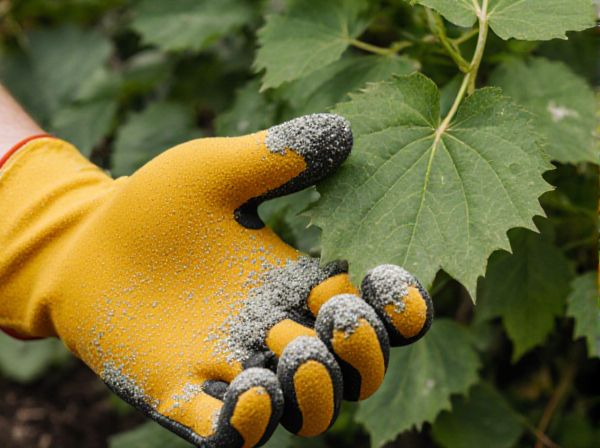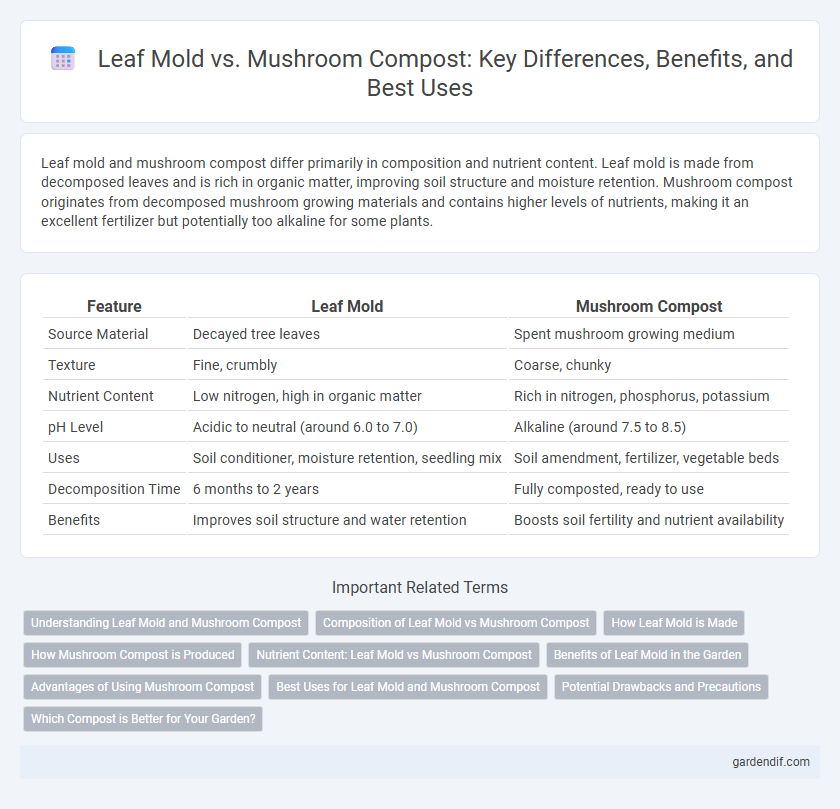
Leaf Mold vs Mushroom Compost Illustration
Leaf mold and mushroom compost differ primarily in composition and nutrient content. Leaf mold is made from decomposed leaves and is rich in organic matter, improving soil structure and moisture retention. Mushroom compost originates from decomposed mushroom growing materials and contains higher levels of nutrients, making it an excellent fertilizer but potentially too alkaline for some plants.
Table of Comparison
| Feature | Leaf Mold | Mushroom Compost |
|---|---|---|
| Source Material | Decayed tree leaves | Spent mushroom growing medium |
| Texture | Fine, crumbly | Coarse, chunky |
| Nutrient Content | Low nitrogen, high in organic matter | Rich in nitrogen, phosphorus, potassium |
| pH Level | Acidic to neutral (around 6.0 to 7.0) | Alkaline (around 7.5 to 8.5) |
| Uses | Soil conditioner, moisture retention, seedling mix | Soil amendment, fertilizer, vegetable beds |
| Decomposition Time | 6 months to 2 years | Fully composted, ready to use |
| Benefits | Improves soil structure and water retention | Boosts soil fertility and nutrient availability |
Understanding Leaf Mold and Mushroom Compost
Leaf mold is a nutrient-rich soil conditioner made from decomposed leaves, enhancing water retention and soil structure by increasing organic matter. Mushroom compost is a byproduct of mushroom farming, composed of straw, manure, and other organic materials, providing rich nutrients ideal for vegetable gardens. Both improve soil health but differ in nutrient content and decomposition processes, with leaf mold focusing on moisture retention and mushroom compost on nutrient enrichment.
Composition of Leaf Mold vs Mushroom Compost
Leaf mold consists primarily of decomposed leaves, rich in organic matter and beneficial fungi, making it excellent for improving soil texture and moisture retention. Mushroom compost is derived from spent mushroom growing substrate, containing a mix of straw, manure, and other organic materials that provide a nutrient-rich medium high in nitrogen and phosphorus. Both types enhance soil fertility but vary significantly in nutrient composition and microbial activity, influencing their specific applications in gardening and agriculture.
How Leaf Mold is Made
Leaf mold is produced by allowing fallen leaves to decompose naturally over time, typically taking 6 to 12 months in a shaded, moist environment, which encourages microbial activity crucial for breaking down the leaves. The process involves piling leaves loosely to maximize aeration and retain moisture, creating an ideal habitat for fungi and bacteria that transform the leaves into dark, crumbly organic matter. This slow decomposition results in a nutrient-rich, soil-conditioning material distinct from mushroom compost, which is derived from spent mushroom beds containing additional organic supplements.
How Mushroom Compost is Produced
Mushroom compost is produced through a controlled process of decomposing organic materials such as straw, hay, corn cobs, and poultry manure, which serve as a nutrient-rich base for mushroom cultivation. The decomposition occurs in large, aerated piles or bays over several weeks, during which beneficial microorganisms break down the materials under specific temperature and moisture conditions. After the mushrooms are harvested, the remaining compost is sterilized and cured, resulting in a nutrient-dense soil amendment ideal for improving soil structure and fertility.
Nutrient Content: Leaf Mold vs Mushroom Compost
Leaf mold is rich in stable humus with high levels of calcium and beneficial fungi, promoting soil structure and moisture retention but has low nitrogen content. Mushroom compost contains higher nutrients, including nitrogen, phosphorus, and potassium, making it more effective as a fertilizer for nutrient-hungry plants. Both compost types improve soil quality but differ significantly in nutrient profiles and applications.
Benefits of Leaf Mold in the Garden
Leaf mold improves soil structure by increasing moisture retention and promoting beneficial microbial activity, which enhances root development and plant growth. It is rich in decomposed organic matter that slowly releases nutrients, making it an excellent soil conditioner and natural fertilizer. Unlike mushroom compost, leaf mold is low in salts and nutrients, reducing the risk of over-fertilization and supporting sustainable garden health.
Advantages of Using Mushroom Compost
Mushroom compost enhances soil fertility by providing a balanced mix of nutrients such as nitrogen, phosphorus, and potassium, which support robust plant growth. It improves soil structure and water retention while suppressing soil-borne diseases thanks to its alkaline pH and organic matter content. Compared to leaf mold, mushroom compost offers longer-lasting nutrient release, making it ideal for enriching garden beds and vegetable patches.
Best Uses for Leaf Mold and Mushroom Compost
Leaf mold excels as a soil conditioner, improving moisture retention and enhancing soil structure due to its high organic matter content. Mushroom compost serves best as a nutrient-rich soil amendment ideal for vegetable gardens and flowerbeds, promoting robust plant growth. Both compost types enrich soil health but differ in nutrient density, making leaf mold preferable for improving soil texture and mushroom compost better for fertilization.
Potential Drawbacks and Precautions
Leaf mold can harbor fungal spores and pests if not fully decomposed, potentially spreading diseases to plants. Mushroom compost often contains high salt levels, which can harm sensitive plants or seed germination if used excessively. Proper curing and application rates are essential to avoid nutrient imbalances and soil toxicity with both compost types.
Which Compost is Better for Your Garden?
Leaf mold enriches soil with organic matter and improves moisture retention, making it ideal for garden beds and acid-loving plants. Mushroom compost, rich in nutrients and alkaline, enhances soil fertility and supports vegetable growth but may raise pH levels. Choosing the best compost depends on your garden's soil type and plant preferences, with leaf mold favoring acidic soils and mushroom compost benefiting neutral to slightly alkaline environments.
Leaf Mold vs Mushroom Compost Infographic

 gardendif.com
gardendif.com